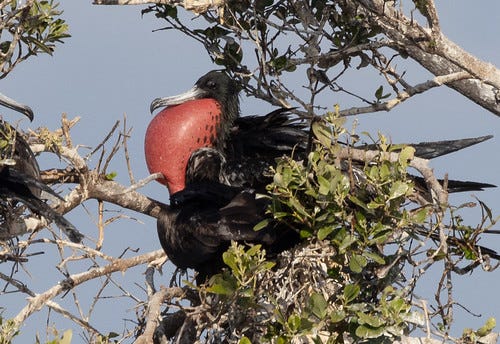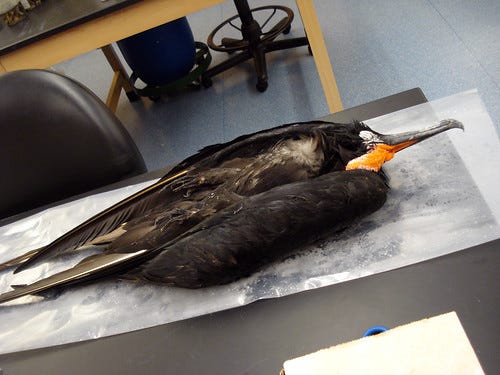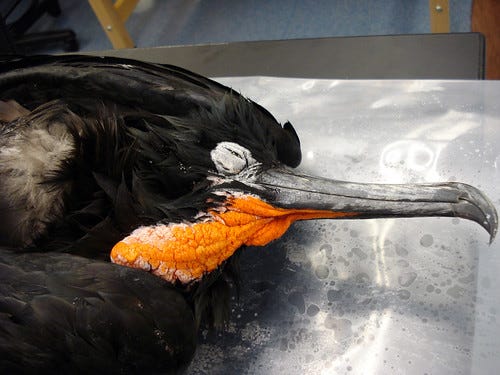(Listen to the radio version here.)

(I’m dashing off this post in the Key West airport before my flight to Miami and then Guyana. The reason there is only a single photo from the Dry Tortugas is because I haven’t had time to deal with photos since we got to our hotel last night. When Russ and I were there in 1997, we didn’t take photos. But the whole reason I needed to go on this trip was to see a breeding male Magnificent Frigatebird with its pouch inflated, so I had to at least pull out one of those.)
In the last week of May in 1997 (almost 30 years ago!), Russ and I took the ferry from Key West in Florida to one of the most remote and least visited of all our national parks, Dry Tortugas. When we were driving through the Keys, I saw my first Magnificent Frigatebirds and Sandwich Terns. The boat didn’t have a naturalist on board to point out birds, but on the four- or five-hour ride I picked out a few Roseate Terns, Audubon’s (now Sargasso) Shearwaters, and Masked Boobies as well as bazillions of frigatebirds. On Garden Key, where Fort Jefferson is, I picked out a few Bridled Terns, who seemed to keep themselves separate from the tens of thousands of similar-looking Sooty Terns. I couldn’t pick out a Black Noddy among so many thousand Brown Noddies, but it was fun trying.
The parade ground within the walls of Fort Jefferson held a recirculating fountain where, during the height of migration, a wonderful assortment of warblers would come for drinking water—the Dry Tortugas are called dry because there is no natural supply of fresh water. But by the last week of May, few migrating songbirds remained, so I didn’t see much at the fountain before our ferry took us back to Key West 3 hours after we arrived.
The Dry Tortugas is the only place in the United States where Magnificent Frigatebirds breed. Their effortless flight—I’ve watched them soaring without flapping at all for many minutes—is, well, magnificent. Frigatebirds are kleptoparasites who spend their lives at sea harassing other seabirds to steal their food, whether it’s a fish carried by a tern or the semi-digested contents of a bigger bird’s stomach—frigatebirds are so huge and aggressive that they often force even large seabirds to disgorge whatever is in their stomachs and the frigatebird gracefully grabs the vomit before it hits the water. Oddly for a bird so entirely limited to ocean waters, frigatebirds can’t swim and their feathers are wettable, meaning if they do somehow get into the water, they’ll never get out.
That’s ironically remarkable, but the most remarkable thing about the Magnificent Frigatebird is the male’s inflatable throat pouch, like a huge red balloon. Late May being very late in their breeding season, I saw only a couple of males with the throat slightly ballooned, and instead of vivid red, it was more of a pale flesh tone.
The ferry didn’t get close to where the breeding colony was. As I recall, Masked Boobies were breeding on Hospital Key, but the ferry passed by at too rapid a pace at too much of a distance for us to get satisfying looks. I could hardly be disappointed—I’d never even seen a frigatebird or Masked Booby before. But as utterly delighted as I was with everything about this trip, I sorely wanted to go back and spend more time at this amazing place.
Since then, the closest I’ve come to seeing a frigatebird’s throat pouch was when one adult male got blown into Ithaca, New York, on September 21, 2008 following an Atlantic hurricane. I was working at the Cornell Lab and had an apartment in Ithaca, so I heard about it in time, but didn’t have the heart to chase such a clearly doomed creature. Sure enough, it was found dead the following morning. People from the Lab retrieved the carcass, so I got to take a few tragic photos. The pouch was of course deflated and mostly hidden. I felt heartbroken seeing such a glorious specimen dead.
I’ve been rather obsessed with seeing a nesting frigatebird with that throat displayed at its best, and two years ago when I went on the VENT tour to South Florida and the Keys, I badly wanted to go on the Dry Tortugas trip extension but it was filled up, as it was last spring—I was on the waiting list both times, but no one cancelled. Last February I signed up to go on this year’s trip, and wow—I’m SO glad I did!
I got great closeup looks at Masked Boobies, saw their nesting colony on East Key (the birds just relocated there from Hospital Key this year), saw bazillions of nesting Brown Noddies and Sooty Terns on Garden Key with bazillions of frigatebirds soaring above, and we rode in a dinghy to the frigatebird nesting colony where I finally saw and got photos of a few males’ fully inflated pouches. Mission accomplished!
One Red-footed Booby was perched atop one of the tallest trees right with the frigatebirds. Our guide, Rafael Galvez—one of the best bird guides I’ve ever spent time with—managed to locate one lone Black Noddy. The parade ground was teeming with warblers and lots of Sharp-shinned Hawks and Merlins, as well as several other birds. Many warblers hadn’t yet arrived—imagine staying here through an entire migration!
There are only a few primitive camping sites at the park. Campers must bring all their own food and water, and stays are limited to three nights unless the ferry is delayed due to bad weather. That’s why we stayed on the boat, riding a dinghy to get to Garden Key or to approach smaller islands to observe the nesting seabirds.
None of the birds on my Dry Tortugas trip were lifers, but two were new for my ABA Continental List—I’d seen both Red-footed Boobies and Black Noddies in Hawaiʻi but nowhere else. But the afternoon before our trip began, I had an unexpected thrill. Rafael let me join his group at Fort Zachary Taylor, where of all things, we found a bird that was a lifer for me—a Bahama Mockingbird. What an auspicious beginning to a wonderful adventure.
After I get home from Guyana on May 11, I’ll be posting bazillions of pictures from both trips. You probably won’t be hearing from me again until then.
(When this went out as an email, I misspelled Rafael’s name!!)







